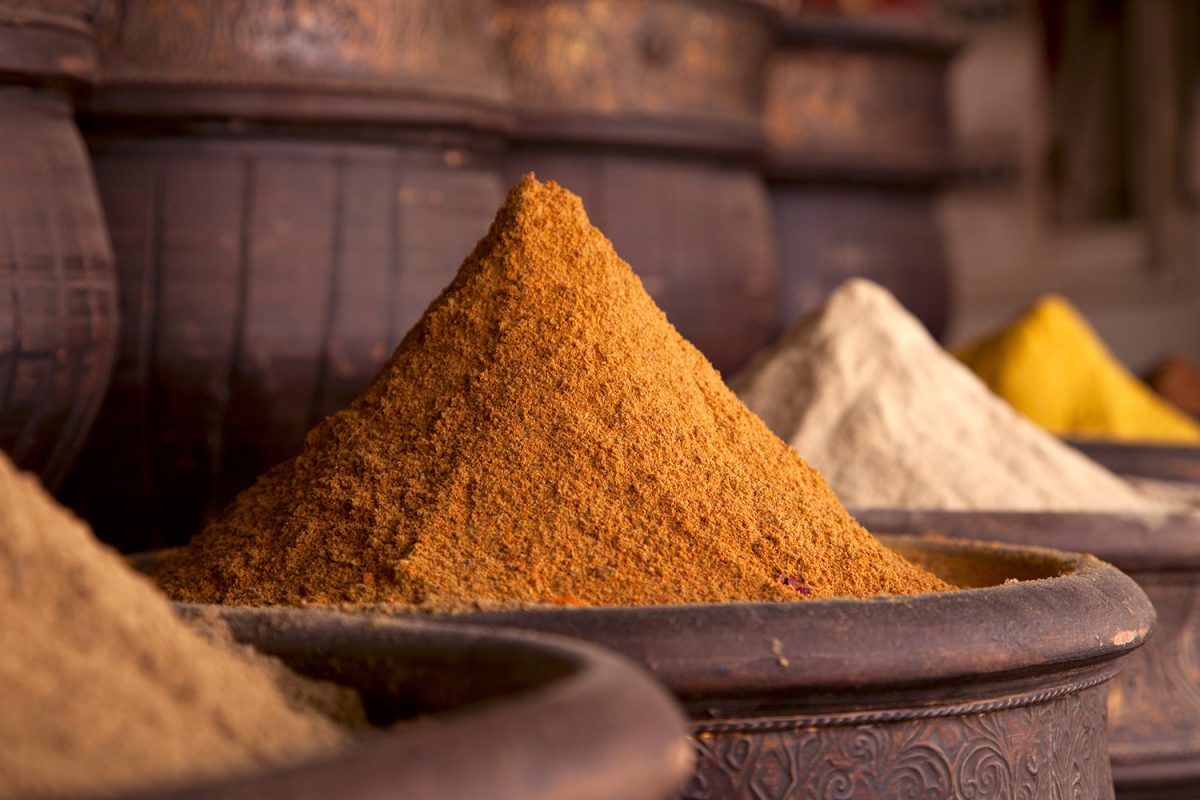Curry is a blend of very fragrant spices that mainly enhances Indian, Asian or West Indian dishes. It is called curry in Thailand and Indonesia, colombo in the West Indies, massalé or garam masala in India, Reunion Island and Mauritius. For some, masala, which means mixture in Indian, is the spice powder that is wrongly called curry while a curry is more the dish cooked with this mixture of spices. But since the term curry is widely answered around the world to also mean this mixture of spices, we will use it as well.
Component of curry powder
A curry powder can be mild, slightly spicy or strongly spicy depending on the spices that compose it.

Curry powder can include a wide range of spices, here are a few that can be found: coriander, cumin, mustard, turmeric, chili, pepper, cubeb, cassia, fenugreek, cardamom, cloves, nutmeg, cinnamon, ginger, fennel, garlic, onion, salt …
If some spices are different in the mixture, there is always at least chili, cumin, ginger, garlic, turmeric and pepper. A basic curry powder contains at least eight spices while it can combine up to 36! It is turmeric that gives it its beautiful dark yellow color. This beautiful mixture with bright yellow and orange colors perfectly adorns various dishes in sauce.
A few words of history
Curry powder appeared around the 18th century. It was Indian merchants who prepared such mixes for the cooks of the British colonial government and the army returning to England. The word curry comes from the Tamil word “kari” which means a stewed meat dish. This exotic mixture then traveled with the British colonists of the East India Company.
The virtues of curry
The different spices that curry powder contains would promote good circulation and help relieve arthritis, rheumatism as well as certain skin infections. Source of vitamin E, magnesium, potassium and vitamin K, curry is also said to stimulate appetite and aid digestion. It is also commonly seen as a good ally against cholesterol and diabete.
The conversation
If possible, it is better to buy your spices whole and grind them yourself with a mortar or a coffee grinder just before using. Avoid leaving them in heat, humidity or light. Store it in a tightly closed jar. After six months of storage, they risk having lost their quality and their fragrance.
What about turmeric?
A pure spice like ginger, turmeric is a species of long, rhizome-shaped underground plant with a beautiful intense yellow-orange color that grows mainly in southern Asia. It also bears the name of “Indian saffron.”
Turmeric has been cultivated in India since Antiquity from the 4th century. We can find data on its use in China around the 7th century and see it was imported into Europe from the 18th century. This popular spice was traded between East and West on the spice route. It was also used as much for its properties in tincture, as in cooking and in medicine. In the past, in French Polynesia, people implored the god Rao when planting this plant so that it would grow in ideal conditions. Curcuma comes from the Sanskrit word kunkuma (which gives a color).

The benefits of turmeric
Another spice that deserves to be incorporated into your recipes, turmeric is recognized for its preventive and curative properties. Rich in antioxidants, it is an excellent ally for digestion. It helps reduce inflammation, promotes better liver health, and helps lower bad cholesterol and fight cancer and gas. Turmeric is also a source of iron and manganese. Ideally, it should be combined with black pepper to optimize its benefits. Black pepper contains piperine which increases the bioavailability of curcumin, the active element in turmeric. In Ayurvedic medicine, it is called the “spice of long life.” Fun fact: turmeric is said to help whiten teeth too!
Which one to choose: curry powder or turmeric?
With its sweet scent, turmeric will coat your dish with a rather discreet flavor and will color it in an appetizing way. As for the curry powder, curry or masala, it will bring an exotic fragrance and a pronounced flavor, more or less spicy depending on the choice of its components in different spices.
Spices, a sneaky source of gluten
Remember that spices are often a hidden source of gluten or cross-contamination… If you have to stick to a gluten-free diet, make sure that the spices purchased are certified gluten-free.
SOURCE :
https://fr.wikipedia.org/wiki/Curry
https://www.lifestylia.com/curry-ou-cari.html
https://ici.radio-canada.ca/actualite/v2/lepicerie/niveau2_4095.shtml
https://fr.wikipedia.org/wiki/Curcuma
https://www.epices-fuchs.fr/epice/curry/
https://www.passeportsante.net/fr/Nutrition/EncyclopedieAliments/Fiche.aspx?doc=curry_nu
